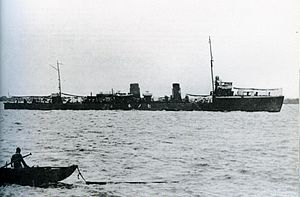Momo-class destroyer
 Hinoki on patrol at Wuhan, China, 1923
| |
| Class overview | |
|---|---|
| Builders | list error: <br /> list (help) Maizuru Naval Arsenal Kure Naval Arsenal |
| Operators | list error: <br /> list (help) |
| Preceded by | Isokaze-class destroyer |
| Succeeded by | Enoki-class destroyer |
| In commission | February 28, 1916 – October 10, 1944 |
| Completed | 4 |
| Active | 0 |
| Lost | 1 |
| Retired | 3 |
| General characteristics | |
| Type | Destroyer |
| Displacement | list error: <br /> list (help) 835 long tons (848 t) normal, 1,080 long tons (1,100 t) full load |
| Length | list error: <br /> list (help) 83.8 m (275 ft) pp, 85.8 m (281 ft) overall |
| Beam | 7.7 m (25 ft) |
| Draught | 2.3 m (7.5 ft) |
| Propulsion | 2-shaft steam turbine, 4 heavy oil-fired boilers 16,700 ihp (12,500 kW) |
| Speed | 31.5 knots (58.3 km/h) |
| Range | 2400 nm @ 15 knots |
| Complement | 110 |
| Armament | list error: <br /> list (help) 3 × QF 4.7 inch Gun Mk I - IV 2 ×6.5mm machine guns 6× 53cm torpedoes |
The Momo class destroyers (桃型駆逐艦, Momogata kuchikukan) was a class of four destroyers of the Imperial Japanese Navy.[1] As with the previous Kaba-class, all were named after trees.
Background
The Momo-class destroyers were designed as part of the first phase of the Hachi-Hachi Kantai program of the Imperial Japanese Navy, at the same time as the large Isokaze-class. With the commissioning of the new high speed battleships Yamashiro and Ise, escort vessels with equally high speed and blue ocean capabilities were required. However, the Japanese Navy could not afford to build many large destroyers, so it was decided to split production between large “1st-class destroyer” (i.e. the Isokaze-class) and a new medium-sized “2nd class destroyer” (i.e. the Momo-class)
Four vessels were built under the fiscal 1915 budget, with the order split between Maizuru Naval Arsenal and Sasebo Naval Arsenal.[2]
Design
The Momo-class ships were a scaled-down version of the Isokaze-class and retained many of the innovations introduced by that class: curved, rather than straight bow, torpedo tubes, geared turbines, and a single-caliber main battery.
Internally, the engines were heavy fuel oil-fired steam turbine engines. Two vessels (Hinoki and Yanagi) used Brown-Curtis turbine engines, and the other two (Momo and Kashi) used Japanese-designed geared turbine engines. The smaller engines gave a smaller rated power of 16,700 shp, which allowed only for a speed of 31.5 knots (58.3 km/h), and limited range due to high fuel consumption.
Armament was slightly less than the Isokaze-class, with three instead of four QF 4.7 inch Gun Mk I - IV guns, pedestal mounted along the centerline of the vessel, front, mid-ship and to the stern. The number of torpedoes was the same as the Isokaze (i.e. two triple launchers).
Operational history
The Momo-class destroyers were completed in time to serve in the very final stages of World War I. As the Japanese 15th Destroyer Flotilla under the cruiser Izumo, they were based at Malta from August 1917.[3] The Japanese fleet was nominally independent, but carried out operations under the direction of the Royal Navy command on Malta, primarily in escort operations for transport and troopship convoys and in anti-submarine warfare operations against German U-boats in the Mediterranean.[4]
Kashi was transferred to the Manchukuo Imperial Navy on May 1, 1937 and was renamed the Hai Wei.[5] However, on June 6, 1942, Hai Wei was transferred back to the Imperial Japanese Navy, and reclassified as the auxiliary escort Kari. It fought in World War II, and was sunk by United States Navy aircraft from TF38 off of Okinawa on October 10, 1944 [6]
The remaining three vessels were retired on April 1, 1940 and broken up, except for Yanagi, which was retained as a training hulk until scrapped in 1947.
List of Ships
| Kanji | Name | Builder | Laid down | Launched | Completed | Fate |
|---|---|---|---|---|---|---|
| 桃 | Momo | Sasebo Naval Arsenal, Japan | 1916-02-28 | 1916-10-12 | 1916-12-23 | BU 1940-04-01 |
| 樫 | Kashi | Maizuru Naval Arsenal, Japan | 1916-03-15 | 1916-12-01 | 1917-03-31 | transferred to Manchukuo 1937-05-01 as Hai Wei returned to IJN 1942-06-29, Sunk in air attack off Okinawa 1944-10-10 |
| 檜 | Hinoki | Maizuru Naval Arsenal, Japan | 1916-05-05 | 1916-12-25 | 1917-03-31 | BU 1940-05-01 |
| 柳 | Yanagi | Sasebo Naval Arsenal, Japan | 1916-10-21 | 1917-02-24 | 1917-05-05 | retired 1940-05-01; training hulk to 1947-04-01 |
See also
![]() Media related to Momo class destroyer at Wikimedia Commons
Media related to Momo class destroyer at Wikimedia Commons
In the movie "Run Silent, Run Deep" Run Silent, Run Deep the US submarine Nerka attacks and sinks a Japanese destroyer called Momo. Whether it was supposed to the Momo itself or just one of Momo-class destroyers in not specified.
References
Books
- Evans, David (1979). Kaigun: Strategy, Tactics, and Technology in the Imperial Japanese Navy, 1887-1941. US Naval Institute Press. ISBN 0-87021-192-7.
- Howarth, Stephen (1983). The Fighting Ships of the Rising Sun: The Drama of the Imperial Japanese Navy, 1895-1945. Atheneum. ISBN 0-689-11402-8.
- Jentsura, Hansgeorg (1976). Warships of the Imperial Japanese Navy, 1869-1945. US Naval Institute Press. ISBN 0-87021-893-X.
External links
- Nishida, Hiroshi. "Materials of IJN: Momo class destroyer". Imperial Japanese Navy.
- Battleships-Cruisers.co.uk. "Japanese destroyers".
Notes
- ^ Jentsura, Warships of the Imperial Japanese Navy, 1869-1945
- ^ Howarth, The Fighting Ships of the Rising Sun
- ^ http://www.naval-history.net/WW1NavyJapanese.htm
- ^ Halpern, Paul G (1994). A Naval History of World War I. Routledge. p. 393. ISBN 1-85728-498-4.
- ^ http://www.battleships-cruisers.co.uk/japanese_destroyers.htm
- ^ http://www.battleships-cruisers.co.uk/japanese_destroyers.htm
